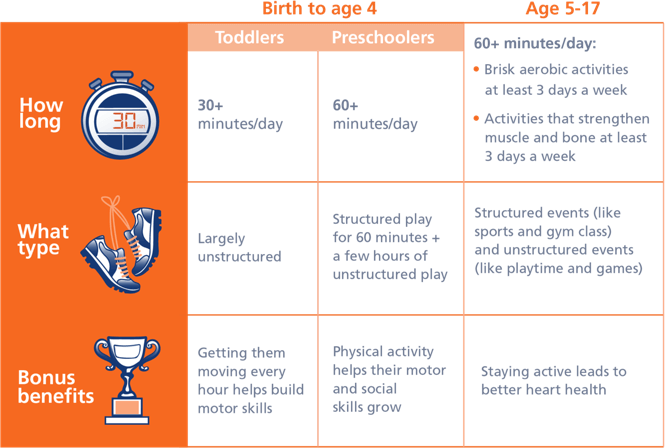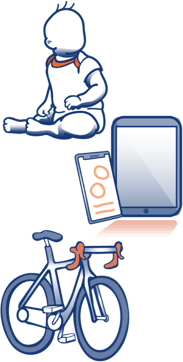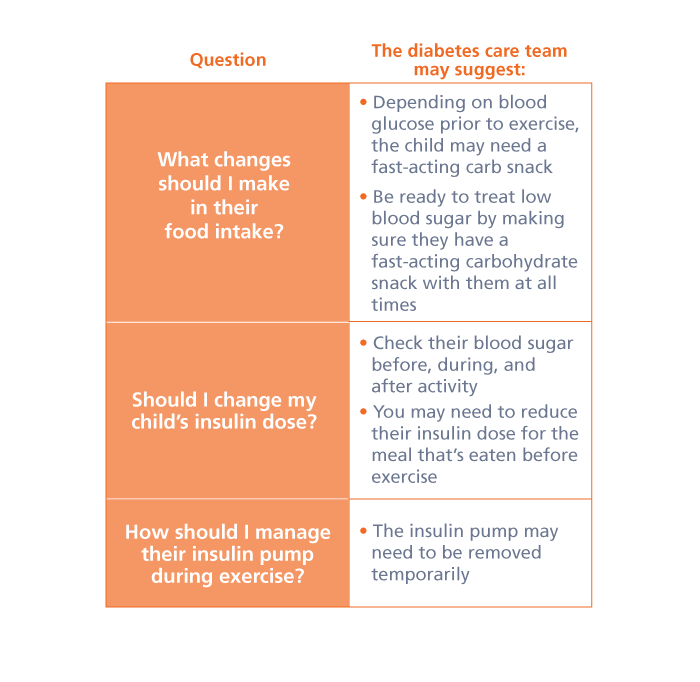
MOVING
Put down that phone!

How to get kids with type 1 diabetes moving.
Helping kids be active in ways that are right for their age, from the time they’re very small to when they become adults, is important. Studies show that children with type 1 diabetes who are not active at all (sedentary) tend to have higher A1CA1CA test that gives you a picture of your average blood glucose level over the past 2 to 3 months. The results can give you an idea of how well your diabetes is being controlled. Also known as "hemoglobin A1C," the A1C test does this by measuring the amount of glucose that has attached to the hemoglobin in your red blood cells. More glucose means a higher A1C. levels than their more active peers.
Age-appropriate activites for kids

Other important information to remember:

Watch closely for low blood glucose. If you’re looking after infants or toddlers, check their blood glucoseBlood glucoseThe main sugar found in the blood, and the body’s main source of energy. often. Children this age may not be able to tell you if they feel low blood glucose symptoms
Limit screen time. Many experts say to limit TV or computer fun time to less than 2 hours per day
Progress counts. You can start small and build up to the recommended time. Even kids who go from being completely inactive to doing half of the activity they should can still get some health benefts
Tips for getting your kid active
You may feel your child or teen is not active enough. But you don’t want to nag them too much and make it a bad experience. So, here are some ways to get them off the couch and out moving—in a way that makes it seem like fun, not work.
- Set a good example by being active yourself. Remember, kids learn from what they see!
- Provide the gear. Find your teen equipment for activities they like: bats, balls, roller skates, bikes, or whatever will get them moving. (Don’t forget the helmets, pads, and other safety equipment they need, too)
- Location matters. Take your teen to places where they can be active, such as parks, baseball fields, or basketball courts. If the weather is good, outdoor play is usually best
- Provide encouragement. Remember to be positive about your kid’s physical activity. Kids who are overweight or not sure about their abilities may need to lose weight or build their skills before they are comfortable playing competitive or team sports
- Make it fun. If your child or teen enjoys an activity, it won’t be such a chore to get them to do it. It doesn’t have to be structured. Remember that walking, running, skating, bicycling, and swimming count, too
- Turn off the TV! After dinner is prime time for TV. But this time can be better spent taking a walk or a bike ride with your teen. You may even want to say 1 day a week is “tech-free”
- “Sneak” it into their daily routine. Whether it’s chores that take “elbow grease,” doing yard work, or walking the dog, find ways your child can get active and help out
How to start safely
Nearly all brisk exercise lasting 30 minutes or more (such as a gym class at school or a football match) will mean adjusting your child’s food intake and/or insulin dose.
What to ask the diabetes care team before your child gets active:

Before making any changes to your child’s treatment plan, talk to their diabetes care teamDiabetes care teamYour diabetes care team may include a primary care doctor, a diabetes and hormone doctor (endocrinologist), a registered nurse, a diabetes educator, a dietitian, a heart doctor (cardiologist), a foot doctor (podiatrist), an eye doctor (ophthalmologist/optometrist), a kidney doctor (nephrologist), a dentist, a pharmacist, and a mental health professional. . They will let you know what your child should eat and teach you how to adjust the insulin dose based on his or her activities.


